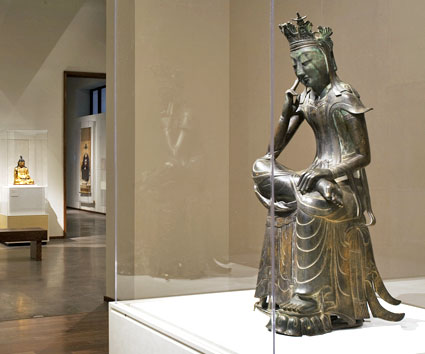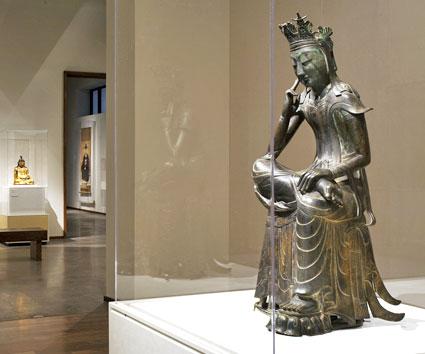Since being appointed a curator for Korean art at an institution outside of Korea, I have developed the habit of asking non-Koreans about the image they have of Korea—either of the country at the present time, or of its past. The majority, whether they have a connection to art or not, cite the tense political situation between the two Koreas. ¶
The responses of Koreans, by contrast, are interestingly different. Foods (such as kimchi and bibimbap), or taekwondo, or the fine arts are almost invariably listed above current political issues. When questioned about what artwork could stand as the nation’s icon or image, no Korean would hesitate to single out the gilt-bronze Pensive Bodhisattva, made in the late sixth century. The Pensive Bodhisattva, National Treasure no. 78 (the numbering of national treasures, incidentally, does not correspond to how they are ranked), exhibits a supreme harmony between idealism and realism as well as international aesthetics versus Korean identity.

Installation view featuring The Pensive Bodhisattva, late sixth century
Koreans’ strong attachment to The Pensive Bodhisattva and their high recognition of its place in Korean art explain the complicated, lengthy procedure involved in being granted a loan of this priceless cultural artifact in time to grace the reopening of LACMA’s new Korean galleries. The first step in this complex negotiation—which took almost a year—was to obtain the approval of the National Museum of Korea, which houses this national treasure. The exporting, or overseas loan, of any Korean cultural artifact must be reviewed and approved by the members of the National Cultural Heritage committee. Among the many subdivisions of this organization, committee members specializing in the relevant particular area of traditional fine art gathered to examine the appropriateness of LACMA to temporarily exhibit this important work of art. With the committee’s approval and endorsement, the request of the three institutions—the National Museum of Korea, the National Cultural Heritage Committee, and LACMA itself—was submitted to the Korean cabinet council, before its ultimately successful application for the personal endorsement of the nation’s president.
The Maitreya Pensive Bodhisattva is in the deep meditation at this moment, but, in the distant future—in about 5.6 billion years—he will come to the human world as a Buddha to save us. If we consider this different measurement, or judgment, of time, the long—sometimes painful—preparation and coordination between several institutions for this significant loan seems merely a short, insignificant moment. The Pensive Bodhisattva will remain in LACMA for three months, making this a rare opportunity to appreciate this uniquely beautiful work of art in the short time we have in this world.
Hyonjeong Kim Han, Associate Curator, Korean Art



